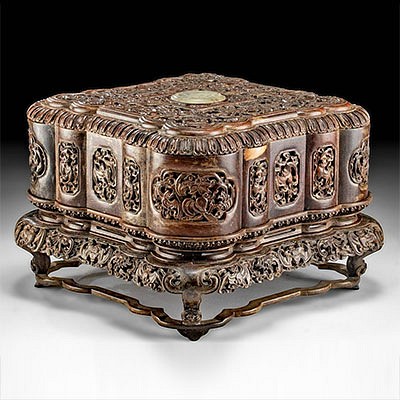19th C. Greek Painting - St. George and the Dragon
Lot 173
About Seller
Artemis Gallery
686 S Taylor Ave, Ste 106
Louisville, CO 80027
United States
Selling antiquities, ancient and ethnographic art online since 1993, Artemis Gallery specializes in Classical Antiquities (Egyptian, Greek, Roman, Near Eastern), Asian, Pre-Columbian, African / Tribal / Oceanographic art. Our extensive inventory includes pottery, stone, metal, wood, glass and textil...Read more
Estimate:
$1,600 - $2,400
Absentee vs Live bid
Two ways to bid:
- Leave a max absentee bid and the platform will bid on your behalf up to your maximum bid during the live auction.
- Bid live during the auction and your bids will be submitted real-time to the auctioneer.
Bid Increments
| Price | Bid Increment |
|---|---|
| $0 | $25 |
| $300 | $50 |
| $1,000 | $100 |
| $2,000 | $250 |
| $5,000 | $500 |
| $10,000 | $1,000 |
| $20,000 | $2,500 |
| $50,000 | $5,000 |
| $100,000 | $10,000 |
| $200,000 | $20,000 |
About Auction
By Artemis Gallery
Apr 8, 2021
Set Reminder
2021-04-08 10:00:00
2021-04-08 10:00:00
America/New_York
Bidsquare
Bidsquare : Fine Antiquities | Asian | Ethnographic Art
https://www.bidsquare.com/auctions/artemis-gallery/fine-antiquities-asian-ethnographic-art-6770
Features classical antiquities, ancient and ethnographic art from cultures encompassing the globe. Egyptian, Greek, Roman, Etruscan, Near Eastern, Asian, Pre-Columbian, Native American, African / Tribal, Oceanic, Spanish Colonial, Russian, Fine Art, so much more! All legally acquired, legal to sell. Artemis Gallery info@artemisgallery.com
Features classical antiquities, ancient and ethnographic art from cultures encompassing the globe. Egyptian, Greek, Roman, Etruscan, Near Eastern, Asian, Pre-Columbian, Native American, African / Tribal, Oceanic, Spanish Colonial, Russian, Fine Art, so much more! All legally acquired, legal to sell. Artemis Gallery info@artemisgallery.com
- Lot Description
Southeastern Europe, Greece, 19th century. Inscribed on the upper right and signed by the artist on the lower right, a finely painted wooden panel depicting Saint George wearing shiny armor atop his white steed and plunging his lance into the fierce dragon below. Princess Elisaba stands at the doorstep of the castle, while the king and queen look on from the balcony above. A fluttering blonde angel hovers in the skies above with a wreath of victory in one hand, while Christ beholds the scene from the upper left corner. A dramatic depiction of this religious theme. Size: 23.75" L x 16.75" W (60.3 cm x 42.5 cm)
Saint George was born in Lydda in Palestine during the 3rd century. He became an officer in the Roman army in the guard of Emperor Diocletian, demonstrating impressive skill in battle and receiving high honor for his courage. When he learned that Diocletian was preparing to persecute Christians, George presented himself publicly before the emperor and denounced him. The legend of "Saint George and the Dragon," which originated in the 12th century, has immortalized the saint. However, this anecdote is rarely presented in iconography. According to tradition, St. George came to Silene in the province of Libya, where a ravaging dragon demanded daily sacrifice. Fate chose the king’s daughter, Elisaba, but George subdued the beast. He told the princess to fasten her sash about the dragon’s neck so it could be led through the town for conversion of the people before it was killed.
Provenance: private Glorieta, New Mexico, USA collection
All items legal to buy/sell under U.S. Statute covering cultural patrimony Code 2600, CHAPTER 14, and are guaranteed to be as described or your money back.
A Certificate of Authenticity will accompany all winning bids.
We ship worldwide and handle all shipping in-house for your convenience.
#163237Surface wear with scuffs and some areas of loss to painted image as shown. Inscribed on the upper right, and signed by the artist on the lower right. Signature on lower right begins with "K.D." however the surname is difficult to decipher. Inactive insect holes. Chips to peripheries. Metal suspension hook on verso and old hooks on upper edge added later.Condition
- Shipping Info
-
All shipping is handled in-house for your convenience. Your invoice from Artemis Gallery will include shipping calculation instructions. If in doubt, please inquire BEFORE bidding for estimated shipping costs for individual items.
-
- Buyer's Premium



 EUR
EUR CAD
CAD AUD
AUD GBP
GBP MXN
MXN HKD
HKD CNY
CNY MYR
MYR SEK
SEK SGD
SGD CHF
CHF THB
THB













